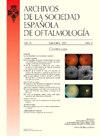Evaluación oculomotora automatizada en el glaucoma congénito primario mediante un dispositivo DIVE: un estudio piloto de fijación, seguimiento ocular y movimientos sacádicos
Q3 Medicine
Archivos De La Sociedad Espanola De Oftalmologia
Pub Date : 2025-10-01
DOI:10.1016/j.oftal.2025.06.016
引用次数: 0
Abstract
Purpose
Primary congenital glaucoma (PCG) is a significant cause of childhood vision loss. While visual acuity can be measured, it does not always reflect visual functioning in daily life, particularly as oculomotor skills are often compromised in ocular disorders. This pilot study assesses oculomotor behavior in children with PCG compared to healthy peers using the device for an integral visual examination.
Methods
Twelve children with PCG (n = 24 eyes) and 24 healthy children (n = 48 eyes), aged 6 months to 4 years, were recruited. The device for an integral visual examination was used for automated oculomotor assessments, measuring fixation (gaze stability, fixation stability, and duration of fixation), saccadic movements (reaction time, peak velocity), and smooth pursuit (latency, gain).
Results
PCG children showed significantly poorer gaze stability in both short (0.68 log degree2 [0.29 to 0.94] vs. 0.15 log degree2 [−0.17 to 0.59]; p < 0.05) and long tasks (1.08 log degree2 [0.79 to 1.84] vs. 0.57 log degree2 [0.30 to 0.85]; p < 0.05), and poorer fixation stability in short (−0.20 log degree2 [−0.27 to −0.17] vs. −0.48 log degree2 [−0.55 to −0.30]; p < 0.05) and long tasks (−0.11 log degree2 [−0.20 to −0.04] vs. −0.41 log degree2 [−0.57 to −0.26]; p < 0.05). Fixation durations were shorter, and saccadic reaction times were longer in the PCG group, while pursuit latency showed no significant difference (p = 0.8118).
Conclusions
Children with PCG have significantly impaired oculomotor behavior, including greater instability in gaze and fixation, shorter fixation durations, and longer saccadic reaction times compared to healthy peers.
使用DIVE装置对原发性先天性青光眼进行自动眼动评估:固定、眼动跟踪和骶骨运动的试点研究
目的原发性先天性青光眼(PCG)是儿童视力丧失的重要原因。虽然视力可以测量,但它并不总是反映日常生活中的视觉功能,特别是在眼部疾病中,动眼力往往受到损害。本初步研究评估了与使用该设备进行整体视觉检查的健康同龄人相比,患有PCG的儿童的动眼肌行为。方法选取12例PCG患儿(n = 24眼)和24例健康儿童(n = 48眼),年龄6个月~ 4岁。整体视觉检查装置用于自动动眼力评估,测量注视(凝视稳定性、注视稳定性和注视持续时间)、扫视运动(反应时间、峰值速度)和平滑追踪(潜伏期、增益)。ResultsPCG孩子显示短期的目光更稳定(0.68日志degree2日志degree2(0.29 - 0.94)和0.15(−0.17到0.59);p & lt; 0.05)和长期任务(1.08日志degree2日志degree2(0.79 - 1.84)和0.57 (0.30 - 0.85);p & lt; 0.05),和贫穷固定稳定短(−0.20日志degree2(−0.27−0.17)与−0.48日志degree2(−0.55−0.30);p & lt; 0.05)和长期任务(−0.11日志degree2(−0.20−0.04)与−0.41日志degree2(−0.57−0.26);p & lt; 0.05)。PCG组注视时间较短,跳眼反应时间较长,追逐潜伏期差异无统计学意义(p = 0.8118)。结论与健康同龄人相比,PCG患儿的眼球运动行为明显受损,包括凝视和注视的不稳定性更大,注视持续时间更短,跳眼反应时间更长。
本文章由计算机程序翻译,如有差异,请以英文原文为准。
求助全文
约1分钟内获得全文
求助全文
来源期刊

Archivos De La Sociedad Espanola De Oftalmologia
Medicine-Ophthalmology
CiteScore
1.20
自引率
0.00%
发文量
109
审稿时长
78 days
期刊介绍:
La revista Archivos de la Sociedad Española de Oftalmología, editada mensualmente por la propia Sociedad, tiene como objetivo publicar trabajos de investigación básica y clínica como artículos originales; casos clínicos, innovaciones técnicas y correlaciones clinicopatológicas en forma de comunicaciones cortas; editoriales; revisiones; cartas al editor; comentarios de libros; información de eventos; noticias personales y anuncios comerciales, así como trabajos de temas históricos y motivos inconográficos relacionados con la Oftalmología. El título abreviado es Arch Soc Esp Oftalmol, y debe ser utilizado en bibliografías, notas a pie de página y referencias bibliográficas.
 求助内容:
求助内容: 应助结果提醒方式:
应助结果提醒方式:


